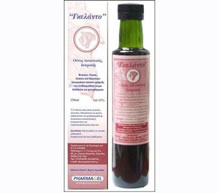
Λεξικό .. Antigen processing and presentation
Antigen processing and presentation
Cells of the mononuclear phagocyte system can be activated to become antigen-presenting cells bearing characteristics class II MHC receptors which induce interaction with T lymphocytes. Antigens opsonized with immunoglobulin and complement interact with cells of the mononuclear phagocyte system. It follows processing of the antigen which is the presented to T-lymphocytes in association with class II MHC antigen on the surface of the phagocyte. T-lymphocytes then produce cytokines which additionally to other functions they activate resting macrophages. This activation enhances their microbicidal, secretory and tumoricidal roles. (See MHC, T lymphocyte Antigen Receptor). The Antigen processing and presentation is described by Pernis:
Protein antigens are recognized by T cells as short fragments that are peptides usually nine aminoacid long, bound to a defined cleft in the polymorphic areas of Class I or Class II major histocompatibility antigens. Peptides destined to be found to Class I are usually generated in the cytosol by a complex proteolytic system that involves addition of ubiquitin as a signal and then proteolysis followed by transfer of the peptides across the membrane of the endoplasmic reticulum (a process performed by appropriate transferring molecules). Here they are bound by the nascent Class I molecules simultaneously with the association of beta-2 microglobulin with the alpha chain of Class I.
The complexes are then transferred, via Golgi and trans-Golgi, to the cell membrane where they will be recognized by the specific clones of CD8 T cells. This way of processing insures that antigens generated in the cytosol, usually derived from viruses, are presented by Class I MHC and that they will therefore be recognized by cytotoxic CD8 T cells that will kill the virus-infected target cell. On the other hand exogenous antigens like bacterial or viral bodies, or proteins derived from them, enter antigen presenting cells by endocytosis, which in the case of B cells, is usually mediated by the membrane immunoglobulins, and reach various endosomal and pre-lysosomal vesicles where they are split by a variety of lysosomal and related enzymes. It is interesting that these vesicles are provided with Class II MHC molecules that are targeted to them from the trans-Golgi by means of anassociated invariant chain. Only after this "detour" through vesicles potentially containing peptides derived from the endocytosed antigens, are the Class II MHC molecules transported to the cell surface where they will be recognized by the specific CD4 T helper cells.
This route of antigen processing and presentation insures that exogenous antigens are recognized by CD4 helper T cells, and that, for instance, a B cell that has bound a soluble protein antigen through its specific membrane immunoglobulins will not be killed, but will instead be helped, by the T cells that recognize the processed protein antigen.
References
Pernis, B.: Antigen processing and presentation. In the New concepts in Clinical Immunology. XIVth ICACI Congress, in Kyoto, Japan, 16th Oct. 1991.
Γκέλης Ν.Δ. - Λεξικό Αλλεργίας - Εκδόσεις ΒΕΛΛΕΡOΦΟΝΤΗΣ - Κόρινθος 2013
Gelis Ν.D. - Dictionary of Allergies - VELLEROFONTIS Publications - Corinth 2013




